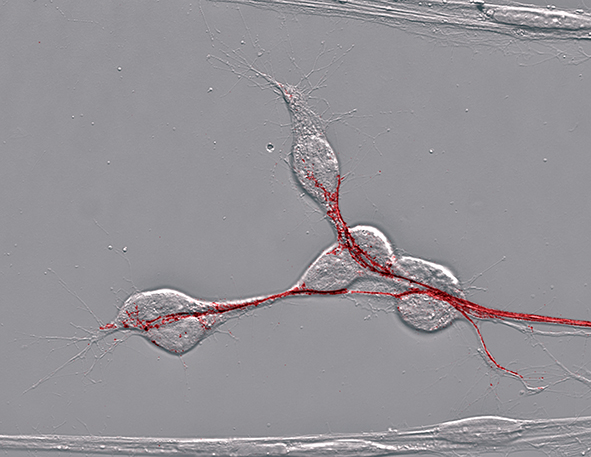Novel test method to replace animal testing

Migrating pioneer neurons under the phase contrast microscope, selectively stained by a fluorescence dye (red). TiHo
„In Germany, animal protection is particularly important and anchored in the constitution. Humans may not cause animals unnecessary pain, suffering or injury”, explains the German Federal Ministry of Education and Research (BMBF). In order to comply with and to extend the protection of animals, a funding program was initiated to support the research for alternatives to animal testing.
New method works without animal testing
Within the course of this program, the TiHo and the LZH are now developing a method to analyze, for example, the neurotoxic properties of industrial chemicals or pesticides. As a result, it shall be possible for the first time to perform these analyses without animal testing.
For this alternative testing system, the TiHo develops a biological analysis method based on an insect embryo that will then be combined with a 3D imaging method of the the LZH. Thereby, disturbances in pioneer neurons caused by chemicals are detected. In these neurons, the growth of the nerve fibers towards the central nervous system is changed. In their fixed developmental patterns, defects in the growth process of neurons, the cell migration and the cell death can be seen. The precise imaging method ensures the detection required for the analysis.
The new methodology allows for high-throughput test series. Applications fields are both fundamental research as well as the pre-regulatory area for the identification of toxicologically relevant substances. Thus, animal tests in the run-up to the approval of chemicals could be replaced.
Avoiding damages in the prenatal and early childhood period
As the new method shall be used for test series to detect developmental neuro toxicity, it is also possible to investigate if individual chemicals or the combination of different substances is potentially harmful for the prenatal or early childhood development. Here, it is tested if the contact can lead to functional limitations or deformations of individual body parts or organs of the child.
Further possible applications
Moreover, the test method can be used for drug development, too. In this field it could complement or, in the long term, even replace ethically questionable and costly animal test series.
The project “Pionieraxon“ (funding code 031L0062B) is supported by the German Federal Ministry of Education and Research (BMBF) within the scope of the announcement “alternatives to animal testing”.
Media Contact
More Information:
http://www.lzh.de/All latest news from the category: Life Sciences and Chemistry
Articles and reports from the Life Sciences and chemistry area deal with applied and basic research into modern biology, chemistry and human medicine.
Valuable information can be found on a range of life sciences fields including bacteriology, biochemistry, bionics, bioinformatics, biophysics, biotechnology, genetics, geobotany, human biology, marine biology, microbiology, molecular biology, cellular biology, zoology, bioinorganic chemistry, microchemistry and environmental chemistry.
Newest articles

NASA: Mystery of life’s handedness deepens
The mystery of why life uses molecules with specific orientations has deepened with a NASA-funded discovery that RNA — a key molecule thought to have potentially held the instructions for…

What are the effects of historic lithium mining on water quality?
Study reveals low levels of common contaminants but high levels of other elements in waters associated with an abandoned lithium mine. Lithium ore and mining waste from a historic lithium…

Quantum-inspired design boosts efficiency of heat-to-electricity conversion
Rice engineers take unconventional route to improving thermophotovoltaic systems. Researchers at Rice University have found a new way to improve a key element of thermophotovoltaic (TPV) systems, which convert heat…



